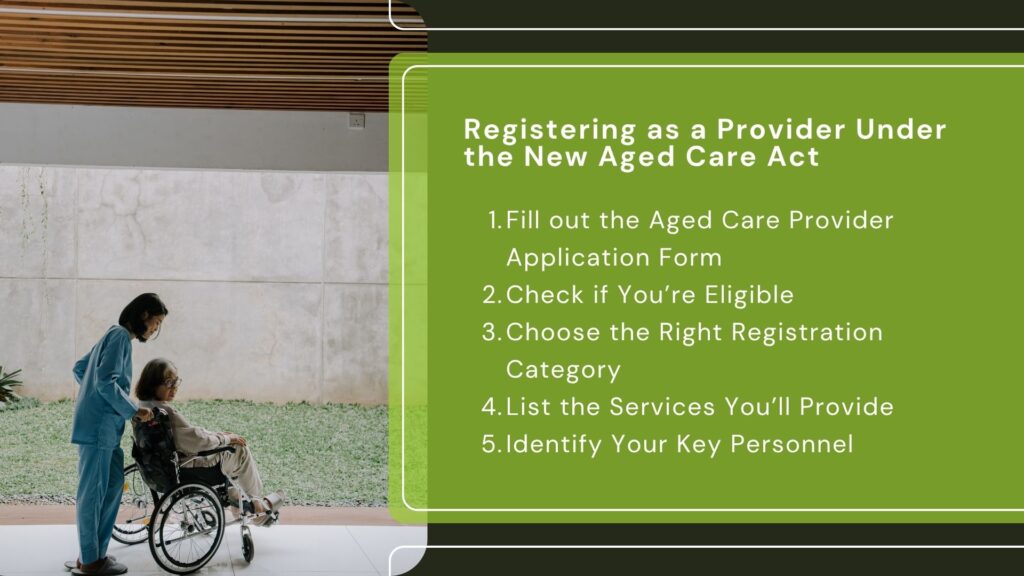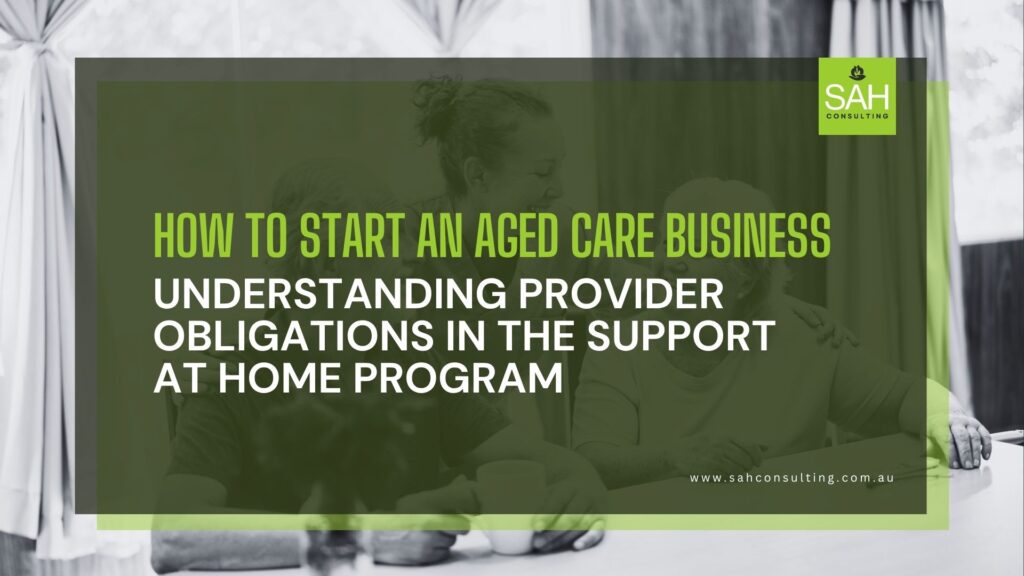Thinking about entering the aged care sector? You’re not alone. With big changes coming under Australia’s new Support at Home (SAH) Programme, now’s a great time to get started. This guide is for you, whether you’re an entrepreneur or a provider, if you want to understand how to start an aged care business and do it the right way from day one.
The SAH Programme is part of Australia’s ongoing aged care reforms. The focus is clear: person-centred, flexible care that helps older Australians stay independent, safe, and respected in their own homes.
This new programme will replace the current Home Care Packages and the Commonwealth Home Support Programme. That means less confusion, better service delivery, and stronger rules for providers. The system is changing and it’s changing fast, so if you’re planning to get involved, it’s time to understand what’s coming and how you can make the most of it.
Understanding the Support at Home Program: Key Changes and Opportunities
What is the Support at Home Programme?
The Support at Home (SAH) Programme is Australia’s next big step in aged care reform. It’s designed to make things simpler for both older Australians and the people who support them. If you’ve been following the Royal Commission into Aged Care Quality and Safety, you’ll know the system needed a serious shake-up. The SAH Programme is part of that shift.
It brings together what used to be two separate programs—the Home Care Packages and the Commonwealth Home Support Programme—into one streamlined model. That means fewer hoops for clients to jump through and more clarity for you as a provider.
What does the SAH Programme aim to do?
The goal is simple: help older Australians live safely and comfortably in their own homes for as long as possible. It’s about giving people real choice in how they get support, with care that fits their lifestyle, not the other way around.
If you’re planning how to start your own aged care business, these are the values that need to guide you:
- Ageing in place – The programme supports older people to stay in their homes, surrounded by the people and routines they love.
- Streamlined assessment and funding – One entry point, one assessment process. This makes it easier for clients to get the support they need quickly.
- Tailored services – Care plans are built around what matters most to the client. It’s about working with goals, not just ticking boxes.
Who Can Become a Provider?
If you’re serious about joining the sector, the good news is the door is open to both existing providers and new entrants. But you do need to meet the registration requirements set under the new Aged Care Act.
Here’s what you’ll need to get started:
- Registration as an approved provider – You’ll need to apply and show you can meet the standards expected under the SAH Programme.
- Specified services – When you register, you’ll need to outline which types of care you’ll deliver. These can include:
- Domestic assistance (cleaning, meal prep, etc.)
- Allied health services (like physio or podiatry)
- Personal care (showering, dressing, grooming)
- Transport and social support
This isn’t just a change in paperwork. It’s a fresh opportunity for you to build a meaningful, community-focused business. The SAH Programme offers a clear path for providers who want to make a difference and build a sustainable business while doing it.
Registering as a Provider Under the New Aged Care Act

If you want to deliver services under the Support at Home Programme, you’ll need to register under the new Aged Care Act. The process is more structured now, but it’s designed to make sure older Australians get safe, high-quality care. Here’s how to get started.
- Fill out the Aged Care Provider Application Form: You’ll need to complete the Aged Care provider application form through the Aged Care Provider Portal.
- Check if You’re Eligible: To register, your business needs to be officially set up in Australia. You must have the right paperwork, a clear structure, proper insurance, and solid systems that support quality care.
- Choose the Right Registration Category: You’ll need to pick a category that matches the kind of services you want to deliver. If you’re offering light support like cleaning or social visits, that’s a lower-risk category.
- List the Services You’ll Provide: Be clear about the services you want to offer. This might include help around the house, transport, personal care, allied health, or nursing support.
- Identify Your Key Personnel: The government will look closely at who’s in charge. These are the people who’ll manage your service and make sure it meets all the rules. Each key person must be suitable for their role.
Understanding Provider Obligations
Once you’re registered, your job doesn’t stop there. You’ll need to meet ongoing obligations under the new Aged Care Act. These rules keep you on track and help make sure older Australians get the safe, respectful care they deserve. Here’s a breakdown of what you need to know.
a. Compliance Agreements
You might be asked to enter into a compliance agreement. These are “agreements to agree”—meaning you commit to doing something in future, like completing staff training or improving your governance systems. They help you stay on the right path without facing immediate penalties.
b. Enforceable Undertakings
These are formal promises to fix a problem, and you must follow through. If you’re asked to complete certain tasks by a deadline, you’ll need to stick to it. Keep clear records of what you’ve done—regulators will check.
c. Governance Responsibilities
You must meet strong governance standards, especially if you’re providing higher-risk services. That means clear leadership, good decision-making processes, and regular reporting. If you had an exemption under the old rules, you’ll need to review it—it may no longer apply.
d. Key Personnel Suitability
Everyone in a key role must pass the fit and proper person test. If someone doesn’t meet the requirements, they can’t stay in the role. It’s your job to make sure your leadership team is suitable and stays that way.
e. Regulatory Notices
You could receive compliance notices, non-compliance notices, or requests for more information. Respond to these quickly and clearly. Ignoring them can lead to bigger issues down the track.
f. Sanctions and Conditions on Registration
Under the new system, there are no more “places” or “extra service status”. Instead, regulators can apply new tools like banning orders, fines, or changes to your registration. These are serious, so make sure you stay compliant.
g. Suspensions and Revocations
If things go wrong, your registration can be suspended or revoked. The process must follow fair procedures and timelines, but it’s important to act fast and cooperate fully. Don’t let small problems turn into big ones.
Common Mistakes New Providers Make (and How to Avoid Them)
Starting strong means knowing what to avoid. Here are some common mistakes new providers make, and how you can steer clear of them.
- Not understanding the new rules – The old system is gone. You need to know exactly how the new laws work. If you’re not sure, get advice early.
- Choosing the wrong key personnel – Your team needs to meet strict suitability standards. Pick people who know the industry and can handle the responsibility.
- Overlooking governance and paperwork – Good governance isn’t optional. Keep your policies up to date and make sure your records are clear and complete.
- Setting the wrong expectations with clients – Be honest about what your services include and how assessments work. Don’t overpromise or cut corners.
Want to know how to become an approved home care provider under the new system? Start by avoiding these mistakes—and get help from those who’ve done it before.
Let SAH Consulting Help You
Getting started in aged care under the new Support at Home Program isn’t easy. Between the detailed registration steps and the strict compliance requirements, things can get confusing fast. You might be wondering where to begin, what documents you need, or how to tick every box without delay.
We work closely with aged care providers like you to make the entire process simple and stress-free. Our team knows the ins and outs of the system, and we’re here to guide you from start to finish.
We’ll help you understand the new rules clearly—no jargon, no guesswork. We’ll also support you in preparing your application form, reviewing key documents, and building policies and procedures that meet all the right standards. Need help training your team or strengthening your governance structure? We do that too.
If you’ve been wondering how to start an aged care business the right way, you don’t have to figure it out alone. With us by your side, you can focus on what really matters—delivering quality care and building a trusted service for older Australians.
Building a Future-Proof Aged Care Business
Now’s the time to act. The full rollout of the Support at Home Program is just around the corner, and being prepared is key. This new model puts quality, dignity, and strong governance at the heart of aged care. If you’re serious about learning how to start an aged care business that’s built to last, start with the right knowledge, the right support, and a commitment to doing things properly.
Need help getting started? Reach out to SAH Consulting today and let’s build your future in aged care together.
